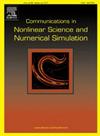Analysis of radiation pressure and albedo effect in the generalized CR3BP with oblateness
IF 3.4
2区 数学
Q1 MATHEMATICS, APPLIED
Communications in Nonlinear Science and Numerical Simulation
Pub Date : 2024-11-22
DOI:10.1016/j.cnsns.2024.108459
引用次数: 0
Abstract
This research investigates the impact of radiation pressure, albedo effect, and oblateness in the generalized Circular Restricted Three-Body Problem (CR3BP). We have considered the bigger primary is a radiating primary and the smaller primary produces the albedo effect. Moreover, the smaller primary is also considered as oblate body with zonal harmonic coefficient . In this study, we have computed the equilibrium points and analyzed their stability, examined zero velocity curves to determine regions of possible motion, and described the periodic orbits around the equilibrium points. We observed that the equilibrium points are more significantly influenced by radiation pressure compared to the albedo effect. Furthermore, larger values of the oblateness parameters and notably impact on the equilibrium points. Moreover, an analysis is performed using the radiation pressure and albedo effect to assess the linear stability of all equilibrium points, and it is found that the collinear points are unstable, whereas, non-collinear equilibrium points are stable. We have obtained periodic orbits around the equilibrium points and observed that the amplitudes in the axes of the periodic orbit around and affected due to consideration of these perturbations, whereas the orbit around is not affected by any of these considered perturbations. This research provides a comprehensive analysis of these perturbations, offering new perspectives on their roles in the generalized CR3BP.
具有扁平性的广义 CR3BP 中的辐射压力和反照率效应分析
本研究探讨了广义圆形受限三体问题(CR3BP)中辐射压力、反照率效应和扁圆度的影响。我们认为较大的原初体是辐射原初体,而较小的原初体会产生反照效应。此外,较小的原生体也被视为扁球体,其带谐波系数 Ji;i=2,4 。在这项研究中,我们计算了平衡点并分析了其稳定性,研究了零速度曲线以确定可能的运动区域,并描述了围绕平衡点的周期轨道。我们发现,与反照率效应相比,辐射压力对平衡点的影响更大。此外,较大的扁平参数 J2 和 J4 值也会对平衡点产生明显影响。此外,我们还利用辐射压力和反照率效应进行了分析,以评估所有平衡点的线性稳定性,结果发现,共线平衡点不稳定,而非共线平衡点则稳定。我们得到了围绕平衡点的周期性轨道,并观察到围绕 L1 和 L2 的周期性轨道的 Y 轴振幅因考虑到这些扰动而受到影响,而围绕 L3 的轨道则不受任何考虑到的扰动的影响。这项研究对这些扰动进行了全面分析,为它们在广义 CR3BP 中的作用提供了新的视角。
本文章由计算机程序翻译,如有差异,请以英文原文为准。
求助全文
约1分钟内获得全文
求助全文
来源期刊

Communications in Nonlinear Science and Numerical Simulation
MATHEMATICS, APPLIED-MATHEMATICS, INTERDISCIPLINARY APPLICATIONS
CiteScore
6.80
自引率
7.70%
发文量
378
审稿时长
78 days
期刊介绍:
The journal publishes original research findings on experimental observation, mathematical modeling, theoretical analysis and numerical simulation, for more accurate description, better prediction or novel application, of nonlinear phenomena in science and engineering. It offers a venue for researchers to make rapid exchange of ideas and techniques in nonlinear science and complexity.
The submission of manuscripts with cross-disciplinary approaches in nonlinear science and complexity is particularly encouraged.
Topics of interest:
Nonlinear differential or delay equations, Lie group analysis and asymptotic methods, Discontinuous systems, Fractals, Fractional calculus and dynamics, Nonlinear effects in quantum mechanics, Nonlinear stochastic processes, Experimental nonlinear science, Time-series and signal analysis, Computational methods and simulations in nonlinear science and engineering, Control of dynamical systems, Synchronization, Lyapunov analysis, High-dimensional chaos and turbulence, Chaos in Hamiltonian systems, Integrable systems and solitons, Collective behavior in many-body systems, Biological physics and networks, Nonlinear mechanical systems, Complex systems and complexity.
No length limitation for contributions is set, but only concisely written manuscripts are published. Brief papers are published on the basis of Rapid Communications. Discussions of previously published papers are welcome.
 求助内容:
求助内容: 应助结果提醒方式:
应助结果提醒方式:


